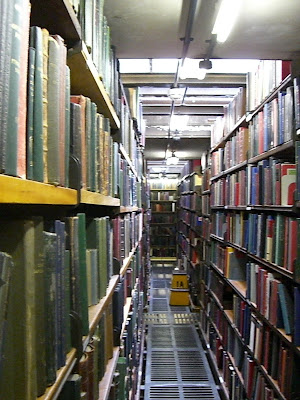The London Library is a private membership library located on St. James Square in London. It was founded in 1841 by Thomas Carlyle. Its founding predated the Libraries Act (of 1850) and it has been funded by member subscriptions ever since.

Since its founding, the library has attracted important literary figures to its membership. A few examples include George Eliot, Charles Darwin, Virginia Woolf, Agatha Christie, and Simon Schama. The current president of the library is playwright Tom Stoppard. The London Library currently has approximately 7,500 members, including both personal and representative members (who represent institutions).
As shown in the diagram above, the London Library is located in a labyrinthine complex. It initially took up one building, but has expanded during several renovations throughout its history. The stacks are open to members, but I imagine that it would be easy to become lost while wandering these stacks until one got used to the place. Not only are they full to the brim with distractingly fascinating books, but the layout is a little disjointed. Part of our group actually got lost briefly when we lingered to look at something interesting and got separated from our tour group. Luckily, we were rescued by a shelver and soon were back with our tour.

The collection includes 1 million volumes, 97% of which are available for loan to members. The majority of the collection focuses on the arts and humanities. It is organized according to a unique classification system developed by Charles Hagberg Wright, librarian from 1893-1940. It is a rational system based on subject. It allows users to browse by subject. The system is supported by the historical richness of the collection and is designed to encourage serendipitous discovery of information. Each new member is given a private induction to the library to aid them in using the classification system.
The library does have a selection of electronic resources that are available for member use online. The library also has an online catalog, but it is only accurate for items obtained after 1950. They are in the process of retrospectively cataloging older materials. A paper catalog is still available and in use in the library.

The London Library does not weed its collection. Books are only discarded in the case of an exact duplicate. Only hard back books are collected and there are no cds or dvds in the collection. Approximately 8,000 new books are obtained each year.
The collection includes books in 50 languages. Foreign language books are not organized into separate sections. Instead, they are shelved with English-language books of the same subject.
In the older part of the building, the stacks are actually a structural feature of the building. The shelves literally hold the building up. The floors are made of grates that can be seen through to the floors below. It is a little unsettling. As I walked down the aisles, I got the feeling that I was in building made out of books.
The library does have a selection of electronic resources that are available for member use online. The library also has an online catalog, but it is only accurate for items obtained after 1950. They are in the process of retrospectively cataloging older materials. A paper catalog is still available and in use in the library.

The London Library is interesting in that it is a private library, but it fills many of the same needs for its users as a public library. The collection is equally appropriate for leisure reading as it is for research. The major difference that stands out to me is that the London Library is completely and directly dependent on its users for funding. The result is an incredibly high standard of customer service. The library has a generous lending policy, no fines, a postal loan service for out-of-town members, and nominal fees for copies.




No comments:
Post a Comment